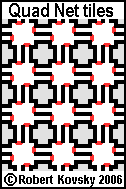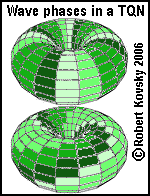
|
A Quad Net (QN) is a proposed physical material made up of interconnecting tiles. A pulsing elemental device occupies each tile and interacts through junctions with its neighbors. Pieces of QN material can be worked into device parts, e.g., a Toroidal Quad Net or TQN that maintains circulating waves of pulses. QN device parts are joined together to make up assemblies of increasing sizes in which various pulse patterns ("phases") are maintained.
During operations, a QN device part cyclically falls into silence, then re-activates, selecting an actual phase from possible phases and maintaining the selected phase as the cycle proceeds. Phase selections are coordinated within assemblies of device parts; and phases are nested within larger phases. In imitation of neuronal signals in brains, some phases ("objects") organize sensations and other phases ("acts") drive muscles. Cyclically selected patterns of pulses in assemblies of QN device parts are models of sensory-motor activities in brains of animals.
|

|
|
In modeling brains, an elemental device mimics a neuron and a Quad Net is an abstract version of a sheet of interacting neurons. Tiled assemblies of QN device parts have an idealized correspondence to arrays of "architectonic modules" that neuroscientists (Arbib et. al.) observe in brains. During operations, QN device parts produce pulse bundles that suggest biological nerve signals driving muscles. There are structural and functional parallels to Edelman's Theory of Neuronal Group Selection; and a central principle of the QN model - proposed Shimmering Sensitivity - resembles Edelman's "reentry" in nature and reach.
QN device operations are described by thermodynamics based on researches by physical scientists into phase changes in natural and engineered systems of diverse kinds, such as water/steam, magnets, metal alloys and liquid crystals. Each system supports multiple distinct aggregate forms ("phases") and each has a "Critical Point" - defined by specific conditions such as a "Critical Temperature" - at which phases easily change into one another, back and forth, through reversible phase transformations. At the Critical Point, phases co-exist (suggesting QN Shimmering) and selection of phases can depend on tiny influences (suggesting QN Sensitivity). Quad Nets embody these principles in devices; and a sheet of Quad Net tiles is an activated cousin of the Ising Model, the tiled mathematical model of Critical Point magnetism.
Proposed large-scale constructions are engineered organisms with animal-like activities. A sensory-motor psychology is based on QN device operations. A construction path looks to Piaget's studies of developing intelligence in children. Basal activities are grounded in sensory-motor coordination and habitual repetition - activity tiling. Operating from this base, a device cyclically selects from among possible phases and realizes one phase. Each phase combines objects and acts; and the combinations are QN form of deeds, e.g., moves in a game of checkers.
|



